Biography
Conrad Marca-Relli (1913-2000)
The son of Italian parents, Marca-Relli was born in Boston on June 5, 1913. His childhood was spent partly in Italy and partly in America until he reached thirteen when his family permanently settled in New York. He began to draw at an early age and said that he had been painting as long as he can remember. In his last year of high school he studied art at night. Later he spent a year at Cooper Union. By this time, in the early 1930’s, the Depression was making it difficult for artists to make a living. Marca-Relli supported himself doing occasional drawings and covers for newspapers and magazines, and with a teaching job.
The creation of the WPA, in 1935, was vitally important to Marca-Relli as it was with so many artists. Here, Marca-Relli was employed as a teacher and then with the easel and mural divisions of the Federal Art Project. For the first time, he earned a living as an artist. Perhaps more important however, was that Marca-Relli came into contact with artists who helped him alter his entire view of painting.
Although he spent his last years settled in Italy, during much of his career he’d been an inveterate and restless traveler absorbing the expression and vibrancy of all the cultures he’d visited. He was primarily self-taught and although de Kooning, Franz Kline, Pollock, Kline and Rothko were among his friends, Marca-Relli had followed an independent, even isolated course. He began as a painter but ultimately turned to collage.
Marca-Relli began his public career as a surrealist painter influenced by de Chirico, Rousseau and Miro. Nevertheless while traveling in Italy, Marca-Relli became absorbed in texture and solidity. The theme of his work during this time was basic horizontal and vertical elements. During a trip to Mexico, however, Marca-Relli made a discovery that was to transform the course of his development as an artist. There he was deeply impressed by the tactile qualities of the sunlit surfaces of adobe buildings. Confronted with a light and structural system he first discovered in Italy he sought the most suitable medium for expressing the environment in which he found himself.
According to the mythology surrounding Marca-Relli, he ran out of paint and, following the course of his work, he began gluing material and paper in order to achieve a greater incisiveness of the borders. He immediately found that collage provided the density and texture he sought. Initially, Marca-Relli applied collage to a series of single figure studies. The anatomy of the body and the spaces around it merge and become the “architecture” of space. The individual figures are sometimes lying down, sleeping or seated. These early collages were created from segments of either raw canvas or natural linen that were pinned to the supporting canvas after they had been coated with a mixture of black paint and glue. Later, he introduced two figures to increase the complexity and expressiveness of his work. Most of these works are large, accentuating the structural quality of the human form. Soon after he introduced volumes of color to his work.
In 1958 Marca-Relli spent a few months in the south of France. While there, his work embodied the sharp contrasts and greater translucence of the Mediterranean light. He also reduced the number of colors to concentrate on the contrast between one dominant hue with strong blacks and whites.
In his work about Marca-Relli, William C. Agee, one-time Assistant Curator of the Whitney Museum of American Art, wrote, “Canvas had become almost too pliable, and Marca-Relli now searched for materials which would offer a greater resiliency to the hand. In 1961 he used thin sheets of metal in several small collages, but metal at that time proved too awkward and inflexible. The next year he discovered in sheets of vinyl plastic the right combination of resistance and flexibility. Works in 1962…use vinyl sheets nailed directly to a wooden support. Following his innate tendency to formal reduction and simplicity, the shapes gradually cast off traces of biomorphism and became progressively fewer in number, larger and more open.
Cristobal and other later works in this series assumed a planar arrangement of horizontal and vertical shapes . . . Volumes of color were added as contrasts to the more neutral and open areas of the natural shades of vinyl. These color volumes also provided a weight, which nudges against and displaces other shapes, creating a slow internal rhythm. That rhythm is irregular and off-beat, caused in art by a deliberate awkwardness in cutting and attaching the plastic.”
Marca-Relli expanded his use of industrial material to aluminum. Ultimately, he began to work in three-dimensional space creating reliefs and freestanding sculptures. After exploring the possibilities of plastics and aluminum, Marca-Relli returned to paint and canvas as the materials of his collages
The body of Marca-Relli’s work is evidence of his inward and outward journeys. Marca-Relli did not see himself as a maker of pictures, but as a seeker, an experimenter, a problem-solver. And although he has friends and affiliations, he listened to only one voice in his creative process, his own. He said, “I think painters should be free to experiment. And that during their experimenting they should be alone, without any interference . . . in order to see whether what they are doing is good or not.”

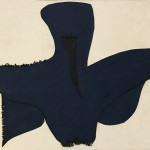 Untitled
Untitled
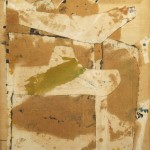 Immagine Opera
Immagine Opera
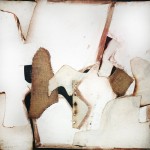 J-S-10-75
J-S-10-75
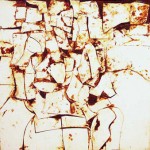 S-3-63
S-3-63
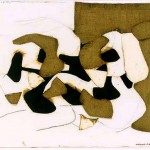 F-D-21-76
F-D-21-76